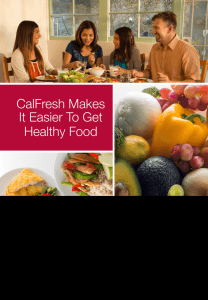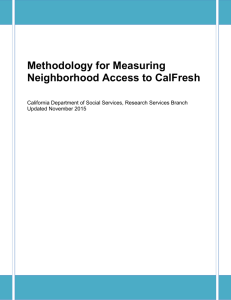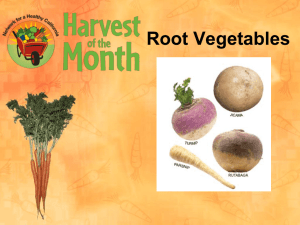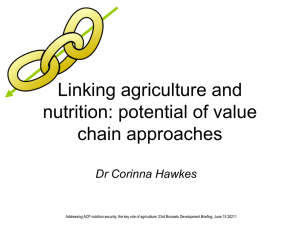CalFresh & Income Support
advertisement
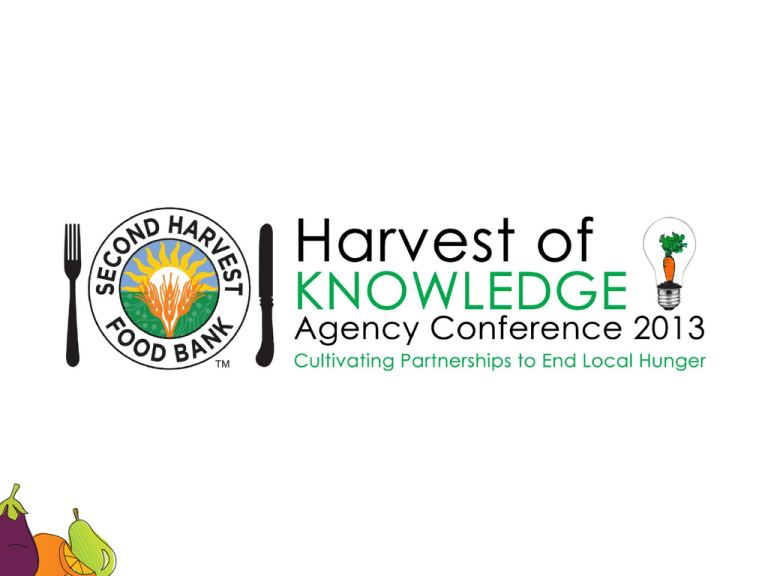
Something for Everyone: Your Role in Increasing CalFresh Access and Participation Alexis Fernández, MSW Nutrition Policy Advocate California Food Policy Advocates 2 Today’s Discussion • Introduction to CFPA & Our Work • Why CalFresh Matters – The CalFresh Facts – CalFresh, Hunger & Food Insecurity – CalFresh & Income Support – CalFresh and Nutritional Quality • The Big Picture • What You Can Do • Q&A 3 Who We Are and What We Do CFPA is a statewide policy and advocacy organization dedicated to improving the health and well-being of low-income Californians by increasing their access to nutritious, affordable food. Visit www.cfpa.net for more info. 4 Focus on the Federal Nutrition Programs • CalFresh/SNAP • National School Lunch Program (NSLP) • School Breakfast Program (SBP) • Child and Adult Care Food Program (CACFP) • Afterschool and Summer Nutrition • Women, Infants, and Children (WIC) And more! 5 Why the Federal Nutrition Programs • Scale, scope, and reach – 4+ million Californians receive CalFresh; just under 4 million more are eligible and do not participate – 2+ million low-income students participate in the school lunch program • Entitlement programs reach those most in need – Benefits must be provided to all eligible applicants – Eligibility is based on income • Strengthen the social safety-net by preventing food insecurity, ensuring sound nutrition and promoting over health and well-being 6 Why CalFresh Matters • The overall health and well-being of your community is protected when we ensure that all individuals and families have access to healthy, affordable food. • The federal nutrition programs can be essential tools in building a healthy, productive community. CalFresh plays a supporting role in the quality of community life and an economy that provides opportunities for all. • Maximum utilization results in maximum impact. Less CalFresh, Means Less for Everyone. 7 The CalFresh Facts: Caseload In 2013 California’s CalFresh caseload has grown to provide benefits to more than 4 million Californians. In January of 2013, over 107,000 individuals received CalFresh benefits in Santa Clara County 8 The CalFresh Facts: Participation • California’s CalFresh participation is the lowest in the country; we only reach 55% of eligible Californians. • This results in a significant loss of federal dollars that could benefit both low-income families via direct nutrition assistance and local economies via related economic activity. – If we increased participation to 100%, California would receive an estimated $4.7 billion in additional federal nutrition benefits. These benefits would generate $8.3 billion in additional economic activity. – If we increased CalFresh participation in Santa Clara County to 100% we could bring in $96 million in benefits for local residents and nearly $172 million in additional economic activity. 9 The CalFresh Facts: Characteristics Average monthly CalFresh benefit: $149.05 – About $1.60 to $1.66 per meal The households: 94% have income below the FPL 36% have income from earnings 38% have more than two people; 39% are single adults 62% include children; 5% include seniors 10 CalFresh, Hunger & Food Insecurity • • 3.8 low-income adults in California were food insecure during the most recent economic downturn. – 1 in 6 Californians had very low food insecurity; double the number from 2001. 96,000 adults in Santa Clara County were food insecure during this same period. • Nearly half of low-income households with children could not afford sufficient food, and approximately 51 percent of Spanish-speaking, lowincome adults experienced food insecurity — the highest level of food insecurity among all low-income groups. • Food insecurity increased in most California counties between 2007 and 2009. Northern Bay Area counties experienced a 14 percent increase, and in Southern California counties other than Los Angeles, there was a 10 percent increase. 11 CalFresh & Income Support 12 CalFresh & Income Support 13 CalFresh & Income Support 14 CalFresh & Income Support 15 CalFresh & Nutritional Quality 16 A Note On Other Nutrition Benefits • CalFresh can’t do it alone! – School breakfast and lunch • 75% of low-income children in Santa Clara County participate in NSLP • Only 32% participate in school breakfast • This low participation rate translates to $11,495,000 in untapped federal meal reimbursements for the county – Child & adult care food program – Women’s, Infants, and Children (WIC) – Emergency food providers • Nutrition benefits work better together. • Combined with CalFresh, the benefits you provide make it more likely that individuals and families have consistent access to nutritious, affordable food. 17 The Big Picture • It’s in the best interest of our communities to ensure all members are able to lead healthy, productive lives. • Hunger, food insecurity, and poverty negatively impact the overall health and well-being of our entire community. • CalFresh plays a significant role in reducing hunger and food insecurity, providing income support, and improving access to healthy, affordable food. • California has a lot of room to improve when it comes to CalFresh participation; we can all do something to assist in this effort. 18 What We’re Doing to Help SHFB is…. • • • • • • Able to support your CalFresh role Hosting application assistors at your site Expanding their commitment to CalFresh Growing their application assistor & outreach team Engaging local decision and policy makers Working with a statewide network of advocates CFPA is… • • • Continuing our advocacy efforts to ensure that every community across the state has simple, straightforward, and consistent access to CalFresh. Focusing on improved customer service so that applying is less burdensome for Californians. Promoting the critical role that nutrition plays in supporting overall health and well-being. 19 What Santa Clara County is doing to help Improvements in your county reflect statewide efforts to improve access to CalFresh. Including significant policy changes to remove the finger imaging requirement and move to semi-annual reporting. Taking steps to improve program access in Santa Clara • Ability to apply online • Kiosks available to complete the online application • Undergoing business process reengineering efforts • Document imaging • After hours voicemail services • Partnering with CBO’s to conduct outreach activities • And more… 20 What You Can Do to Help 21 22 What Will You Do? 23 Contact Information Alexis Fernandez, MSW Nutrition Policy Advocate California Food Policy Advocates Email: alexis@cfpa.net Phone: 510.433.1122 x111 Website: www.cfpa.net 24
